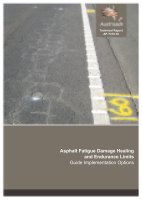Pavement

Asphalt Fatigue Damage Healing and Endurance Limits: Guide Implementation Options
- Publication no: AP-T319-16
- ISBN: 978-1-925451-55-9
- Published: 22 December 2016
- PDF (free) Download
Overseas research has suggested that asphalt fatigue endurance limit may exist, where applied strain is sufficiently low no fatigue damage accumulates in the asphalt as the rate of asphalt healing exceeds the rate of damage accumulation. The existence of such limits has implications for design of thick asphalt pavements including potential reductions in pavement thickness under certain conditions.
This report:
- summarises laboratory, computer modelling and field studies conducted to identify and validate the asphalt endurance limit concept
- summarises asphalt design procedures used overseas which incorporate an asphalt fatigue endurance limit
- discusses options for revision of the Austroads pavement design procedures.
- Summary
- 1. Introduction
- 2. University of Illinois Laboratory Research
- 2.1. Introduction
- 2.2. Use of Rate of Dissipated Energy Change (RDEC)
- 2.3. Fatigue Life Prediction for Mix Modulus and Volumetrics
- 2.4. Discontinuity in Laboratory Fatigue Relationship
- 2.5. Use of Plateau Value to Estimate Endurance Strain Limit
- 2.6. Laboratory ELS Relationships
- 2.6.1. Prediction of ELS from Mix Modulus
- 2.6.2. ELS Prediction from Mix Modulus and Volumetrics
- 2.7. Effect of Rest Periods on ELS
- 2.8. Summary
- 3. NCHRP Project 9-44A Laboratory Endurance Limits
- 3.1. Introduction
- 3.2. Overview of Methodology
- 3.3. Materials Tested
- 3.4. Beam Fatigue Testing
- 3.5. Test Program
- 3.6. Data Used to Develop the Stiffness Ratio Prediction Method
- 3.7. Relationship to Predict Stiffness Ratio from Modulus
- 3.8. Laboratory Beam Endurance Limit Strains
- 3.9. Further Analysis of Laboratory Beam Results
- 3.9.1. Stiffness Ratio Prediction Relationship
- 3.9.2. Laboratory Beam Endurance Limits in Terms of Volumetrics and Temperature
- 3.10. Summary
- 4. Field Studies
- 4.1. United Kingdom
- 4.2. Australia
- 4.3. United States of America
- 4.3.1. Analysis of USA LTPP Data
- 4.3.2. Analysis of NCAT Accelerated Loading Data
- 4.4. Summary of Field Studies
- 5. Asphalt Pavement Solutions for Life Project
- 5.1. Introduction
- 5.2. Outline of the Proposed Method
- 5.3. Summary of Method Development
- 5.3.1. Introduction
- 5.3.2. Laboratory ELS Relationship
- 5.3.3. Selection of Pavement Sections for Field Calibration
- 5.3.4. Determination of Moduli and Asphalt Strains
- 5.3.5. Determination of In-service ELS Relationship
- 5.3.6. In-service ELS Relationship Proposed for the Guide
- 5.4. Summary
- 6. Use of Asphalt Fatigue Endurance Limits in Overseas Design Processes
- 6.1. Introduction
- 6.2. United Kingdom
- 6.3. United States of America
- 6.3.1. AASHTO Design Method
- 6.3.2. Texas Department of Transportation
- 6.3.3. Illinois Department of Transportation
- 6.4. Summary
- 7. Options for Austroads Design Guide
- 7.1. The Need
- 7.2. Option A: APS-fL Method to Estimate ELS from Asphalt Modulus
- 7.3. Option B: NCHRP 9-44A Method to Calculate ELS from Modulus
- 7.4. Option C: NCHRP 9-44A Estimating ELS from Temperature and Mix Volumetrics
- 7.5. Option D: Limiting Design Traffic Loading
- 7.6. Option E: Modify Fatigue Relationship to Allow for Healing at Elevated Temperatures
- 7.7. PSWG Recommendation for the Austroads Guide
- 8. Summary
- References
- Appendix A Asphalt Pavement Solutions for Life Design Examples
- A.1 Introduction
- A.2 Design Inputs
- A.2.1 Introduction
- A.2.2 Working Platform
- A.2.3 Asphalt Mix Types
- A.2.4 Temperatures
- A.2.5 Asphalt Moduli
- A.2.6 Asphalt Strain at Fatigue Endurance Limit
- A.3 Design Examples
- A.3.1 Effect of Endurance Strains for Selected Subgrade Strengths
- A.3.2 Effect of Endurance Limit Strains for Selected Cities
- A.3.3 Effect of Endurance Limit Strains for Variations of Asphalt Mix Type
- A.3.4 Effect of Endurance Limit Strains when Current Road Agency Asphalt Moduli are Used
- Appendix B In-Service Endurance Strain Limits Derived from NCHRP Project 9-44A
- B.1 Introduction
- B.2 Limiting Strain-asphalt Modulus Relationship
- B.2.1 Relationship Derived from Laboratory Beam Fatigue Testing
- B.2.2 Field Adjustment Factor
- B.2.3 Limiting Strain vs ModulusE Relationship
- B.3 Limiting Strain – Temperature Relationship
- B.3.1 Relationship Derived from Laboratory Testing
- B.3.2 Field Adjustment Factor
- B.3.3 Limiting Strain vs Temperature Relationship
- Appendix C Proposed Part 2 Text
- Section 6.5.6
- 8.2.5. Traffic loading limits due to asphalt crack healing
Related publications
WEB-R708-24
Latest Pavement News
